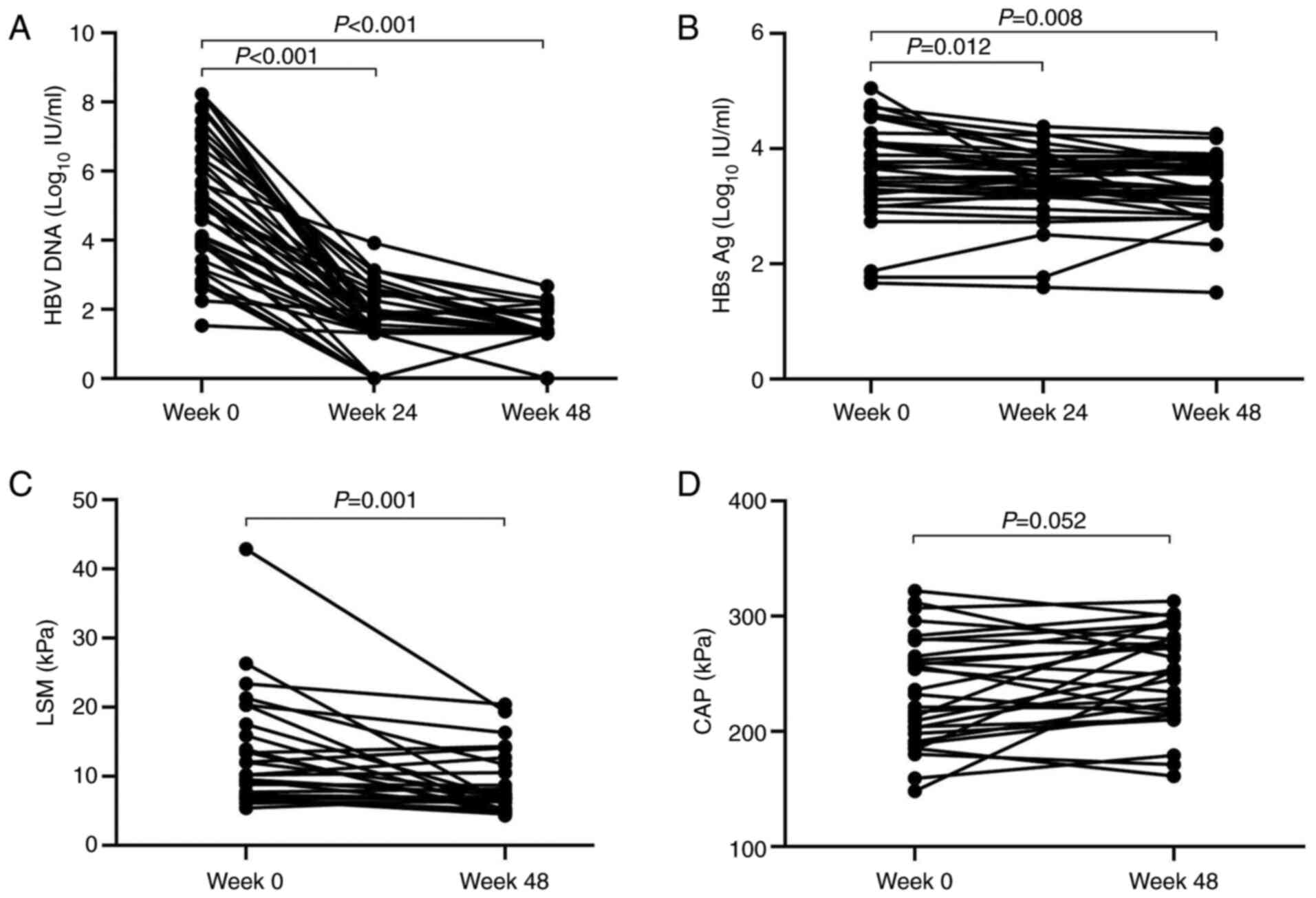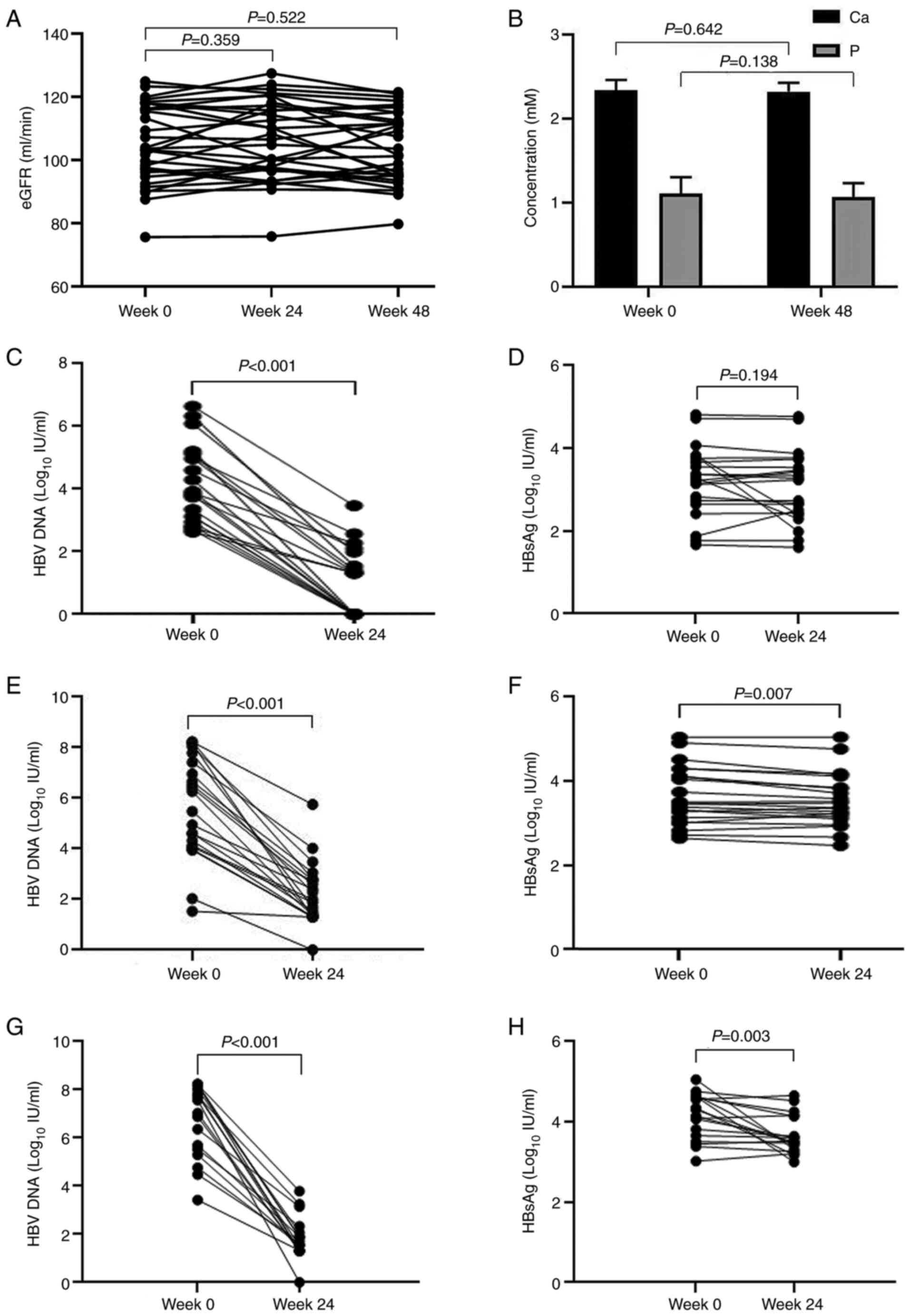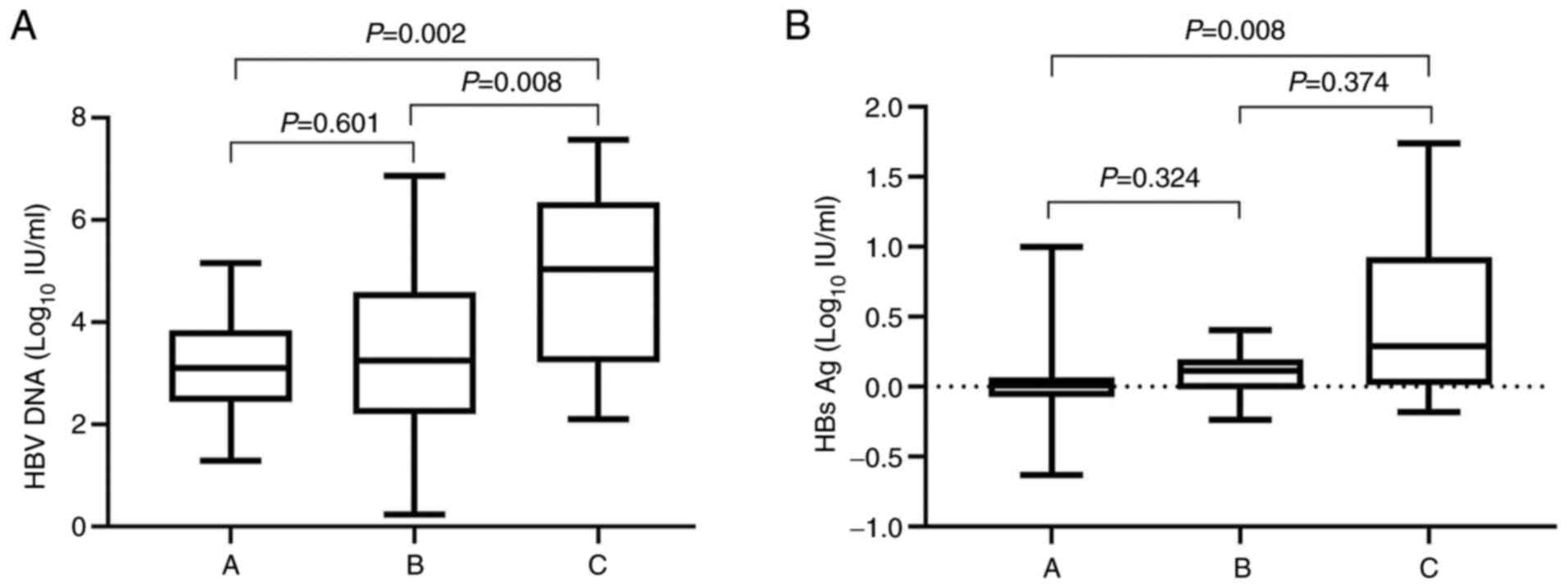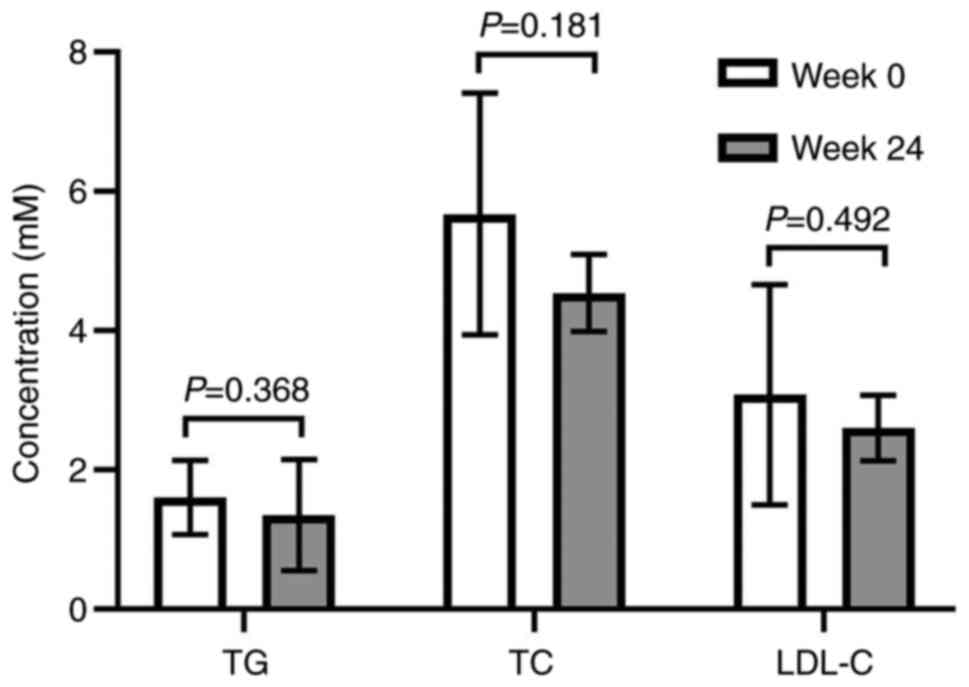|
1
|
Agarwal K, Brunetto M, Seto WK, Lim YS,
Fung S, Marcellin P, Ahn SH, Izumi N, Chuang WL, Bae H, et al:
GS-US-320-0110; GS-US-320-0108 Investigators. 96 weeks treatment of
tenofovir alafenamide vs. tenofovir disoproxil fumarate for
hepatitis B virus infection. J Hepatol. 68:672–681. 2018.PubMed/NCBI View Article : Google Scholar
|
|
2
|
Hou J, Ning Q, Duan Z, Chen Y, Xie Q, Wang
FS, Zhang L, Wu S, Tang H, Li J, et al: GS-US-320-0110 and
GS-US-320-0108 China Investigators: 3-year Treatment of Tenofovir
Alafenamide vs. Tenofovir Disoproxil Fumarate for Chronic HBV
Infection in China. J Clin Transl Hepatol. 9:324–334.
2021.PubMed/NCBI View Article : Google Scholar
|
|
3
|
Agarwal K, Fung SK, Nguyen TT, Cheng W,
Sicard E, Ryder SD, Flaherty JF, Lawson E, Zhao S, Subramanian GM,
et al: Twenty-eight day safety, antiviral activity, and
pharmacokinetics of tenofovir alafenamide for treatment of chronic
hepatitis B infection. J Hepatol. 62:533–540. 2015.PubMed/NCBI View Article : Google Scholar
|
|
4
|
Chinese Society of Infectious Diseases,
Chinese Medical Association; Chinese Society of Hepatology, Chinese
Medical Association. The guidelines of prevention and treatment for
chronic hepatitis B (2019 version). Zhonghua Gan Zang Bing Za Zhi.
27:938–961. 2019.PubMed/NCBI View Article : Google Scholar : (In Chinese).
|
|
5
|
Roade L, Loglio A, Borghi M,
Riveiro-Barciela M, Soffredini R, Facchetti F, di Paolo D,
Tabernero D, Lunghi G, Esteban R, et al: Application of EASL 2017
criteria for switching hepatitis B patients from tenofovir
disoproxil to entecavir or tenofovir alafenamide. Dig Liver Dis.
52:1164–1169. 2020.PubMed/NCBI View Article : Google Scholar
|
|
6
|
Buti M, Gane E, Seto WK, Chan HL, Chuang
WL, Stepanova T, Hui AJ, Lim YS, Mehta R, Janssen HL, et al:
GS-US-320-0108 Investigators: Tenofovir alafenamide versus
tenofovir disoproxil fumarate for the treatment of patients with
HBeAg-negative chronic hepatitis B virus infection: A randomised,
double-blind, phase 3, non-inferiority trial. Lancet Gastroenterol
Hepatol. 1:196–206. 2016.PubMed/NCBI View Article : Google Scholar
|
|
7
|
Buti M, Roade L, Riveiro-Barciela M and
Esteban R: Optimal management of chronic hepatitis B patients
receiving nucleos(t)ide analogues. Liver Int. 40 (Suppl 1):15–21.
2020.PubMed/NCBI View Article : Google Scholar
|
|
8
|
Chan HL, Fung S, Seto WK, Chuang WL, Chen
CY, Kim HJ, Hui AJ, Janssen HL, Chowdhury A, Tsang TY, et al:
GS-US-320-0110 Investigators: Tenofovir alafenamide versus
tenofovir disoproxil fumarate for the treatment of HBeAg-positive
chronic hepatitis B virus infection: A randomised, double-blind,
phase 3, non-inferiority trial. Lancet Gastroenterol Hepatol.
1:185–195. 2016.PubMed/NCBI View Article : Google Scholar
|
|
9
|
Chang TT, Lai CL, Kew Yoon S, Lee SS,
Coelho HS, Carrilho FJ, Poordad F, Halota W, Horsmans Y, Tsai N, et
al: Entecavir treatment for up to 5 years in patients with
hepatitis B e antigen-positive chronic hepatitis B. Hepatology.
51:422–430. 2010.PubMed/NCBI View Article : Google Scholar
|
|
10
|
Funk AL, Lu Y, Yoshida K, Zhao T,
Boucheron P, van Holten J, Chou R, Bulterys M and Shimakawa Y:
Efficacy and safety of antiviral prophylaxis during pregnancy to
prevent mother-to-child transmission of hepatitis B virus: A
systematic review and meta-analysis. Lancet Infect Dis. 21:70–84.
2021.PubMed/NCBI View Article : Google Scholar
|
|
11
|
Chao DT, Lim JK, Ayoub WS, Nguyen LH and
Nguyen MH: Systematic review with meta-analysis: The proportion of
chronic hepatitis B patients with normal alanine transaminase ≤40
IU/L and significant hepatic fibrosis. Aliment Pharmacol Ther.
39:349–358. 2014.PubMed/NCBI View Article : Google Scholar
|
|
12
|
Razavi-Shearer D, Gamkrelidze I, Nguyen
MH, Chen D-S, Van Damme P, Abbas Z, Abdulla M, Abou Rached A, Adda
D, Aho I, et al: Polaris Observatory Collaborators: Global
prevalence, treatment, and prevention of hepatitis B virus
infection in 2016: A modelling study. Lancet Gastroenterol Hepatol.
3:383–403. 2018.
|
|
13
|
Ogawa E, Furusyo N and Nguyen MH:
Tenofovir alafenamide in the treatment of chronic hepatitis B:
Design, development, and place in therapy. Drug Des Devel Ther.
11:3197–3204. 2017.PubMed/NCBI View Article : Google Scholar
|
|
14
|
Hou JL, Gao ZL, Xie Q, Zhang JM, Sheng JF,
Cheng J, Chen CW, Mao Q, Zhao W, Ren H, et al: Tenofovir disoproxil
fumarate vs adefovir dipivoxil in Chinese patients with chronic
hepatitis B after 48 weeks: A randomized controlled trial. J Viral
Hepat. 22:85–93. 2015.PubMed/NCBI View Article : Google Scholar
|
|
15
|
Ibrahim F, Campbell L, Bailey AC,
Stockwell S, Waters L, Orkin C, Johnson M, Gompels M, De
Burgh-Thomas A, Jones R, et al: Estimated glomerular filtration
rate slopes on tenofovir alafenamide. HIV Med. 21:607–612.
2020.PubMed/NCBI View Article : Google Scholar
|
|
16
|
Kanda Y: Investigation of the freely
available easy-to-use software ‘EZR’ for medical statistics. Bone
Marrow Transplant. 48:452–458. 2013.PubMed/NCBI View Article : Google Scholar
|
|
17
|
Liang X, Gao Z, Xie Q, Zhang J, Sheng J,
Cheng J, Chen C, Mao Q, Zhao W, Ren H, et al: Long-term efficacy
and safety of tenofovir disoproxil fumarate in Chinese patients
with chronic hepatitis B: 5-year results. Hepatol Int. 13:260–269.
2019.PubMed/NCBI View Article : Google Scholar
|
|
18
|
Lampertico P, Agarwal K, Berg T, Buti M,
Janssen HLA, Papatheodoridis G, Zoulim F and Tacke F: European
Association for the Study of the Liver. Electronic address:
easloffice@easloffice.eu; European Association for the Study of the
Liver. EASL 2017 Clinical Practice Guidelines on the management of
hepatitis B virus infection. J Hepatol. 67:370–398. 2017.PubMed/NCBI View Article : Google Scholar
|
|
19
|
Marcellin P, Buti M, Krastev Z, de Man RA,
Zeuzem S, Lou L, Gaggar A, Flaherty JF, Massetto B, Lin L, et al:
Kinetics of hepatitis B surface antigen loss in patients with
HBeAg-positive chronic hepatitis B treated with tenofovir
disoproxil fumarate. J Hepatol. 61:1228–1237. 2014.PubMed/NCBI View Article : Google Scholar
|
|
20
|
Marcellin P, Gane E, Buti M, Afdhal N,
Sievert W, Jacobson IM, Washington MK, Germanidis G, Flaherty JF,
Aguilar Schall R, et al: Regression of cirrhosis during treatment
with tenofovir disoproxil fumarate for chronic hepatitis B: A
5-year open-label follow-up study. Lancet. 381:468–475.
2013.PubMed/NCBI View Article : Google Scholar
|
|
21
|
Milinkovic A, Berger F, Arenas-Pinto A and
Mauss S: Reversible effect on lipids by switching from tenofovir
disoproxil fumarate to tenofovir alafenamide and back. AIDS.
33:2387–2391. 2019.PubMed/NCBI View Article : Google Scholar
|
|
22
|
Mills A, Arribas JR, Andrade-Villanueva J,
DiPerri G, Van Lunzen J, Koenig E, Elion R, Cavassini M, Madruga
JV, Brunetta J, et al: Switching from tenofovir disoproxil fumarate
to tenofovir alafenamide in antiretroviral regimens for
virologically suppressed adults with HIV-1 infection: a randomised,
active-controlled, multicentre, open-label, phase 3,
non-inferiority study. Lancet Infect Dis. 16:43–52. 2016.PubMed/NCBI View Article : Google Scholar
|
|
23
|
Roade L, Riveiro-Barciela M, Esteban R and
Buti M: Long-term efficacy and safety of nucleos(t)ides analogues
in patients with chronic hepatitis B. Ther Adv Infect Dis.
8(2049936120985954)2021.PubMed/NCBI View Article : Google Scholar
|
|
24
|
Hou J, Wang G, Wang F, Cheng J, Ren H,
Zhuang H, Sun J, Li L, Li J, Meng Q, et al: Chinese Society of
Hepatology, Chinese Medical Association; Chinese Society of
Infectious Diseases, Chinese Medical Association. Guideline of
Prevention and Treatment for Chronic Hepatitis B (2015 Update). J
Clin Transl Hepatol. 5:297–318. 2017.PubMed/NCBI View Article : Google Scholar
|
|
25
|
Jia JD, Hou JL, Wei L and Zhuang H:
Highlights of the guidelines of prevention and treatment for
chronic hepatitis B (2019 version). Zhonghua Gan Zang Bing Za Zhi.
28:21–23. 2020.PubMed/NCBI View Article : Google Scholar : (In Chinese).
|
|
26
|
Sax PE, Wohl D, Yin MT, Post F, DeJesus E,
Saag M, Pozniak A, Thompson M, Podzamczer D, Molina JM, et al:
GS-US-292-0104/0111 Study Team: Tenofovir alafenamide versus
tenofovir disoproxil fumarate, coformulated with elvitegravir,
cobicistat, and emtricitabine, for initial treatment of HIV-1
infection: Two randomised, double-blind, phase 3, non-inferiority
trials. Lancet. 385:2606–2615. 2015.PubMed/NCBI View Article : Google Scholar
|
|
27
|
Zhang J, Du X, Zhou Z, Lv F and Yu Y:
Spleen thickness can predict significant liver pathology in
patients with chronic hepatitis B with persistently normal alanine
aminotransferase or minimally raised alanine aminotransferase: A
retrospective study. J Int Med Res. 47:122–132. 2019.PubMed/NCBI View Article : Google Scholar
|
|
28
|
Nguyen LH, Chao D, Lim JK, Ayoub W and
Nguyen MH: Histologic changes in liver tissue from patients with
chronic hepatitis B and minimal increases in levels of alanine
aminotransferase: A meta-analysis and systematic review. Clin
Gastroenterol Hepatol. 12:1262–1266. 2014.PubMed/NCBI View Article : Google Scholar
|
|
29
|
Terrault NA, Lok ASF, McMahon BJ, Chang
KM, Hwang JP, Jonas MM, Brown RS Jr, Bzowej NH and Wong JB: Update
on prevention, diagnosis, and treatment of chronic hepatitis B:
AASLD 2018 hepatitis B guidance. Hepatology. 67:1560–1599.
2018.PubMed/NCBI View Article : Google Scholar
|
|
30
|
Wang H, Luo H, Wan X, Fu X, Mao Q, Xiang
X, Zhou Y, He W, Zhang J, Guo Y, Tan W and Deng G: TNF-α/IFN-γ
profile of HBV-specific CD4 T cells is associated with liver damage
and viral clearance in chronic HBV infection. J Hepato. l72:45–56.
2020.PubMed/NCBI View Article : Google Scholar
|
|
31
|
Tong MJ, Pan CQ, Han SB, Lu DS, Raman S,
Hu KQ, Lim JK, Hann HW and Min AD: An expert consensus for the
management of chronic hepatitis B in Asian Americans. Aliment
Pharmacol Ther. 47:1181–1200. 2018.PubMed/NCBI View Article : Google Scholar
|
|
32
|
Wong WWL, Pechivanoglou P, Wong J,
Bielecki JM, Haines A, Erman A, Saeed Y, Phoon A, Tadrous M, Younis
M, et al: Antiviral treatment for treatment-naïve chronic hepatitis
B: Systematic review and network meta-analysis of randomized
controlled trials. Syst Rev. 8(207)2019.PubMed/NCBI View Article : Google Scholar
|
|
33
|
Tao X, Lu Y, Zhou Y, Zhang L and Chen Y:
Efficacy and safety of the regimens containing tenofovir
alafenamide versus tenofovir disoproxil fumarate in fixed-dose
single-tablet regimens for initial treatment of HIV-1 infection: A
meta-analysis of randomized controlled trials. Int J Infect Dis.
93:108–117. 2020.PubMed/NCBI View Article : Google Scholar
|
|
34
|
Zhou K, Contag C, Whitaker E and Terrault
N: Spontaneous loss of surface antigen among adults living with
chronic hepatitis B virus infection: A systematic review and pooled
meta-analyses. Lancet Gastroenterol Hepatol. 4:227–238.
2019.PubMed/NCBI View Article : Google Scholar
|
|
35
|
Huhn GD, Wilkin A, Mussini C, Spinner CD,
Jezorwski J, El Ghazi M, Van Landuyt E, Lathouwers E, Brown K and
Baugh B: AMBER and EMERALD study groups. Week 96 subgroup analyses
of the phase 3, randomized AMBER and EMERALD trials evaluating the
efficacy and safety of the once daily
darunavir/cobicistat/emtricitabine/tenofovir alafenamide
(D/C/F/TAF) single-tablet regimen in antiretroviral treatment
(ART)-naïve and -experienced, virologically-suppressed adults
living with HIV-1. HIV Res Clin Pract. 21:151–167. 2021.PubMed/NCBI View Article : Google Scholar
|


















